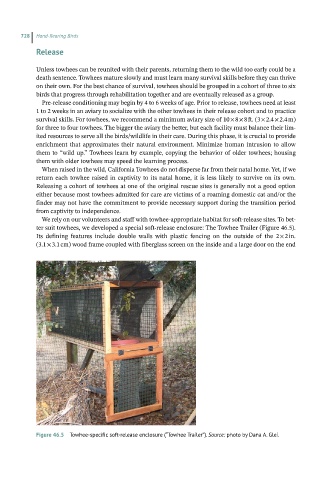Page 726 - Hand rearing birds second
P. 726
728 Hand-Rearing Birds
Release
Unless towhees can be reunited with their parents, returning them to the wild too early could be a
death sentence. Towhees mature slowly and must learn many survival skills before they can thrive
on their own. For the best chance of survival, towhees should be grouped in a cohort of three to six
birds that progress through rehabilitation together and are eventually released as a group.
Pre‐release conditioning may begin by 4 to 6 weeks of age. Prior to release, towhees need at least
1 to 2 weeks in an aviary to socialize with the other towhees in their release cohort and to practice
survival skills. For towhees, we recommend a minimum aviary size of 10 × 8 × 8 ft. (3 × 2.4 × 2.4 m)
for three to four towhees. The bigger the aviary the better, but each facility must balance their lim-
ited resources to serve all the birds/wildlife in their care. During this phase, it is crucial to provide
enrichment that approximates their natural environment. Minimize human intrusion to allow
them to “wild up.” Towhees learn by example, copying the behavior of older towhees; housing
them with older towhees may speed the learning process.
When raised in the wild, California Towhees do not disperse far from their natal home. Yet, if we
return each towhee raised in captivity to its natal home, it is less likely to survive on its own.
Releasing a cohort of towhees at one of the original rescue sites is generally not a good option
either because most towhees admitted for care are victims of a roaming domestic cat and/or the
finder may not have the commitment to provide necessary support during the transition period
from captivity to independence.
We rely on our volunteers and staff with towhee‐appropriate habitat for soft‐release sites. To bet-
ter suit towhees, we developed a special soft‐release enclosure: The Towhee Trailer (Figure 46.5).
Its defining features include double walls with plastic fencing on the outside of the 2 × 2 in.
(3.1 × 3.1 cm) wood frame coupled with fiberglass screen on the inside and a large door on the end
Figure 46.5 Towhee-specific soft-release enclosure (“Towhee Trailer”). Source: photo by Dana A. Glei.

